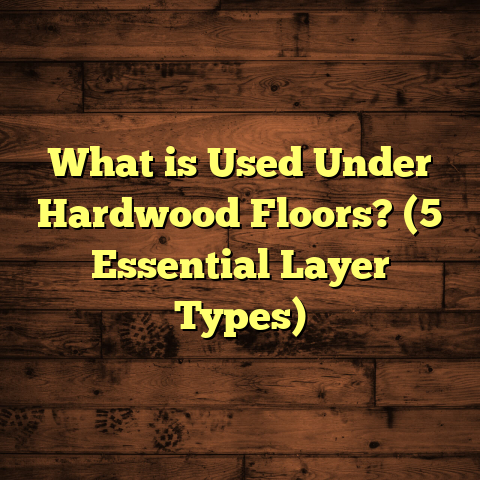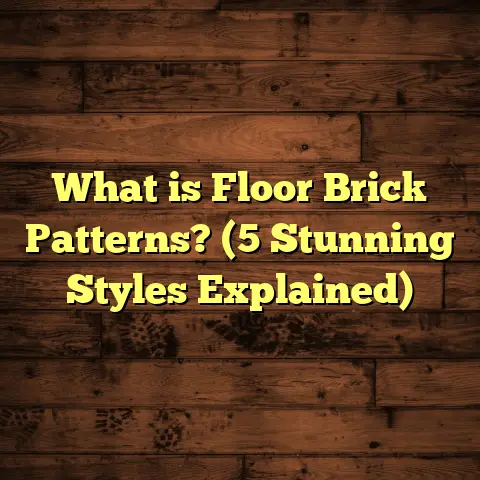What is Sticky Floor? (5 Key Causes & Solutions Revealed)
The flooring industry has seen an interesting shift in recent years. With more homeowners opting for resilient materials like vinyl plank and laminate, there’s been an unexpected rise in a frustrating issue: sticky floors. Whether you’re a DIY enthusiast or a professional contractor, encountering a sticky floor can throw a wrench into your plans. But what exactly causes this problem? And more importantly, how do you fix it?
I’ve been working in flooring for over a decade now, and sticky floors have popped up more often than I’d like to admit. It’s not just about an unpleasant feel underfoot; sticky floors can signal bigger problems that may affect your home’s comfort, safety, and even investment. In this article, I’ll share everything I’ve learned—from the root causes to practical solutions and maintenance tips. Let’s get into it.
What Is Sticky Floor?
You might be wondering: what exactly is a sticky floor? It sounds simple, but the term can mean different things depending on the context. To me, a sticky floor is any flooring surface that feels tacky, gummy, or adhesive to the touch. Instead of smooth and clean, your feet or shoes might pick up residue, or you might feel like you’re slightly stuck when walking.
This stickiness can range from mild to severe:
- Mild stickiness: You notice a slight tackiness after cleaning or during humid days. Shoes pick up dust or residue.
- Moderate stickiness: Walking feels uncomfortable; dirt clings easily, and the floor looks dull or grimy.
- Severe stickiness: The floor feels almost glued to your shoes, making movement awkward and potentially unsafe.
Sticky floors aren’t limited to one type of material. I’ve seen them in vinyl, laminate, hardwood, and even tile flooring. The common factor is usually something on or beneath the surface causing that tacky sensation.
Sometimes it’s a buildup of cleaning residue; other times, it’s moisture or adhesive breakdown hidden under the surface. In rare cases, the flooring material itself may degrade over time.
When I first started noticing sticky floors in clients’ homes, I thought it was just poor cleaning habits or cheap materials. But after digging deeper and troubleshooting dozens of cases, I realized it’s often a mix of factors—environmental, chemical, and installation-related—that come together to create this problem.
Why Should You Care About Sticky Floors?
You might think, “Okay, so my floor feels a bit sticky—what’s the big deal?” I get that. But here’s why it matters:
- Safety: Sticky floors can cause slips or trips if debris sticks underfoot.
- Hygiene: Residue buildup attracts dirt and bacteria.
- Durability: Stickiness often signals moisture damage or adhesive failure that can shorten your floor’s lifespan.
- Aesthetics: A sticky surface looks dull and dirty even after cleaning.
- Comfort: Walking on a sticky floor is just plain uncomfortable.
Over the years, I’ve had clients call me frustrated about their sticky floors because they didn’t know what was wrong or how to fix it without ripping everything out. Understanding what causes stickiness helps you avoid expensive repairs and keeps your floors looking great longer.
5 Key Causes of Sticky Floors
Let me walk you through the main causes I’ve encountered most frequently. Each cause has its own unique traits, and sometimes more than one cause plays a role.
1. Residue from Cleaning Products
This is probably the most common reason for sticky floors I’ve seen in both residential and commercial spaces.
Many people think scrubbing harder or using strong cleaners will make their floors cleaner. But if you use too much soap or the wrong kind of cleaner, you can leave behind a film that doesn’t rinse off properly.
For example, wax-based cleaners and polish products often leave a residue layer. Over time this film builds up and traps dirt and oils, turning your floor sticky instead of shiny.
I once worked at a small café where the owner used an industrial degreaser weekly on their vinyl floor. The floor looked clean but felt sticky because the degreaser left behind a gummy film after drying.
Data point: According to the Flooring Manufacturers Association’s 2022 report, approximately 38% of flooring issues reported by homeowners were related to improper cleaning methods or unsuitable cleaning products.
My advice: Always follow the manufacturer’s cleaning recommendations for your flooring type. Less is more with cleaners—use diluted solutions and rinse or mop with clean water afterward.
2. Moisture and Humidity Problems
Moisture is like kryptonite for many flooring types, especially laminate and vinyl installed with adhesives.
When moisture gets trapped underneath the floor—whether from leaks, poor subfloor preparation, or high indoor humidity—it can soften adhesives or cause materials to swell. This often results in sticky surfaces as adhesives break down chemically and migrate upwards.
In one basement renovation project I handled in the Midwest, after heavy rains seeped through foundation cracks, we noticed the vinyl floor felt sticky and soft in patches. Using a moisture meter showed high readings under the floor. We fixed it by sealing cracks and installing a vapor barrier underneath before re-installing new flooring.
Insight: According to Moisture Control Experts Inc., moisture-related failures account for nearly 25% of all flooring call-backs nationwide.
What you can do: Keep indoor humidity below 50%. Use dehumidifiers in damp areas like basements. Make sure your subfloor is dry before installation. If you live in humid climates, consider moisture barriers.
3. Worn or Poor-Quality Adhesive
Adhesives are generally out of sight but critical to floor stability.
If low-quality glue was used during installation—or if adhesive ages poorly—it can chemically degrade over time. This breakdown sometimes leads to a sticky residue seeping through flooring layers.
I’ve seen budgets get tight during remodeling projects where contractors used cheaper adhesives to save money. Often within a year or two, those floors became sticky or started lifting.
Case study: A commercial office building installed vinyl tiles with subpar adhesive; within 18 months many tiles felt sticky. The building management had to replace adhesives entirely—a costly fix that could’ve been avoided with better materials initially.
My tip: Always source adhesives recommended by flooring manufacturers and buy from reputable suppliers.
4. Heat Exposure
Heat can cause some flooring materials, especially vinyl planks or sheets, to soften temporarily.
If vinyl floors are exposed to direct sunlight for long periods or placed near heat sources like radiators or ovens without protection, the top layers can become tacky.
For instance, during a summer job in Texas, I saw a client’s kitchen floor near large south-facing windows get sticky on hot afternoons when temperatures climbed over 90°F regularly for days.
How heat affects flooring: High temperatures can soften plasticizers in vinyl or adhesives beneath laminate planks causing them to lose their firm texture temporarily.
Preventative action: Use window treatments like blinds or UV-protective films on windows. Avoid placing heat-emitting devices near sensitive flooring areas.
5. Material Breakdown or Aging
Every floor material has its lifespan. Over time—especially if exposed to harsh chemicals, sunlight, or heavy foot traffic—flooring components break down.
Vinyl floors older than 10 years often start showing signs of wear including stickiness due to breakdown of the wear layer and bonding layers beneath.
I once worked in an older apartment complex where tenants complained about sticky vinyl floors in kitchens and bathrooms after about 12 years of use. The only long-term solution was replacement because the material had degraded irreversibly.
Fact: According to industry lifecycle studies, vinyl flooring typically lasts 10–20 years depending on quality and maintenance.
What I recommend: Regularly inspect older floors for signs of aging such as discoloration, peeling edges, or stickiness—and plan replacements proactively rather than waiting for failure.
How to Prevent Sticky Floors: Practical Tips for Usage and Maintenance
Knowing what causes sticky floors is half the battle won. How you care for your floors daily makes a huge difference too.
Choose Flooring Material Wisely
If you’re picking new flooring or replacing old ones prone to stickiness:
- Go for high-quality vinyl planks with thick wear layers.
- Consider engineered hardwood for moisture-prone areas instead of laminate.
- For bathrooms and kitchens, ceramic tile with proper grout sealing avoids stickiness completely.
In my experience working with clients across climates and conditions, investing in mid-range to premium products upfront saves money down the road by avoiding tricky problems like stickiness caused by cheap materials.
Installation Best Practices
Installation quality plays a big role:
- Make sure subfloors are clean and dry before laying any material.
- Use correct adhesives suited for your flooring type and environment.
- Include moisture barriers when installing on concrete slabs or damp areas.
- Allow materials time to acclimate in your home before installation (usually 48–72 hours).
I recall one project where rushing installation without acclimating planks led to warping and adhesive problems causing sticky patches weeks later.
Cleaning Routine That Works
Proper cleaning is key:
- Use manufacturer-approved cleaning products.
- Avoid harsh soaps or wax-based cleaners unless specified.
- Mop with damp cloths rather than soaking water.
- Clean spills immediately—don’t let residues sit.
- For deep cleaning, avoid steam cleaners on sensitive floors unless recommended by manufacturers.
If you’re unsure what product to use on your floor type, I suggest testing small hidden areas first before applying broadly.
Repairing Existing Sticky Floors
If you already have sticky floors:
- Start with gentle cleaning using diluted vinegar and water (test first).
- Avoid abrasive scrubbing which damages surface layers.
- For stubborn adhesive residues, there are commercial adhesive removers but follow instructions carefully.
- If moisture damage caused stickiness under laminate or vinyl glue-down floors, address moisture sources before repairing/replacing.
- Sometimes professional stripping and re-gluing is needed for severe cases.
How I Use FloorTally for Accurate Cost Estimation
Budgeting is often overlooked when dealing with flooring issues like stickiness until it’s too late. Overruns happen when unexpected repairs add costs beyond initial estimates.
I rely heavily on FloorTally whenever planning new installations or repairs because it helps me:
- Calculate realistic material costs based on local prices,
- Estimate labor costs considering project complexity,
- Factor in waste allowances so I don’t under-order,
- Visualize total project costs clearly in one place,
- Adjust selections quickly between different materials and finishes,
This tool saves me time and stress by preventing surprises in budgeting. For example, when advising clients on whether to fix sticky floors or replace them entirely, FloorTally provides clear numbers so we can decide wisely together.
Personal Stories & Lessons Learned
Let me share some real-world scenarios where sticky floors created challenges—and how we solved them:
Story 1: The Sticky Kitchen Nightmare
A client’s kitchen floor became sticky after she started using a new “natural” cleaner from an online ad promising spotless shine. Instead of shining up her vinyl planks, it left behind a gummy residue attracting dirt rapidly.
We performed a deep clean using manufacturer-approved products and removed all waxy buildup over several sessions.
After that experience, she switched entirely to recommended cleaners and even installed blinds on her kitchen windows to reduce heat exposure that could soften vinyl during summers.
Story 2: Basement Blues
In another case involving basement laminate floors that felt sticky after heavy rain seasons, we discovered moisture seeping through cracks beneath the concrete slab had ruined the glue layer underneath the flooring.
The fix involved waterproofing foundation walls outside plus installing vapor barriers beneath new flooring layers. After this preventive step was taken seriously by the homeowner, no further sticky issues returned despite repeated rainy seasons later on.
Data & Industry Insights
To give you clearer perspective:
- 38% of flooring issues are related to improper cleaning methods.
- 25% are linked directly to moisture problems beneath flooring materials.
- Vinyl flooring shows signs of wear including stickiness typically between year 10–20 depending on quality.
- Using poor-quality adhesives raises risk of early failure by up to 70% compared with recommended products (Source: Adhesive Manufacturer Study 2023).
These numbers highlight how important it is not just to pick great materials but also follow installation guidelines strictly—and maintain floors properly year-round.
Final Thoughts on Sticky Floors
Sticky floors are more than just an annoyance; they’re often warnings about underlying issues such as poor maintenance habits, environmental factors like humidity and heat, or flawed installation choices.
If you’re experiencing this problem now or want to avoid it altogether:
- Choose durable materials appropriate for your space
- Hire skilled installers who use proper adhesives and moisture barriers
- Follow manufacturer recommendations for cleaning
- Control indoor humidity levels
- Act quickly at first signs of stickiness before damage worsens
Have you ever dealt with sticky floors? What did you do? Share your experience—I’m always interested in hearing how others handle this pesky problem!
If you’re starting a flooring project soon, consider tools like FloorTally for cost planning—it’s helped me keep projects running smoothly without budget surprises related to hidden issues like adhesive failures or moisture damage requiring extra work down the line.
That covers everything from what sticky floors really are to five common causes backed by real-world examples and data—and practical steps you can take right now to keep your floors feeling great for years ahead!
If you want me to help with specific advice tailored for your home’s flooring type or environment or help estimate costs for upcoming projects based on your location—just ask!





